Fluid Sensors Market Research, 2030
The global fluid sensors market was valued at $13.2 billion in 2021, and is projected to reach $25.4 billion by 2030, growing at a CAGR of 7.45% from 2022 to 2030. A fluid sensor is an electrical device that monitors or controls the flow of liquids and gases through pipes and tubes.
Fluid sensors are commonly used in conjunction with gauges to render measurements, but they can also be used in conjunction with computers and digital interfaces. They are used to measure things like pressure, temperature, level control, and the volume of fluid moving through them, among other things. Fluid sensors are used in a variety of industries, including oil & gas, water & wastewater, chemical, power generation, food and beverage, and automotive.
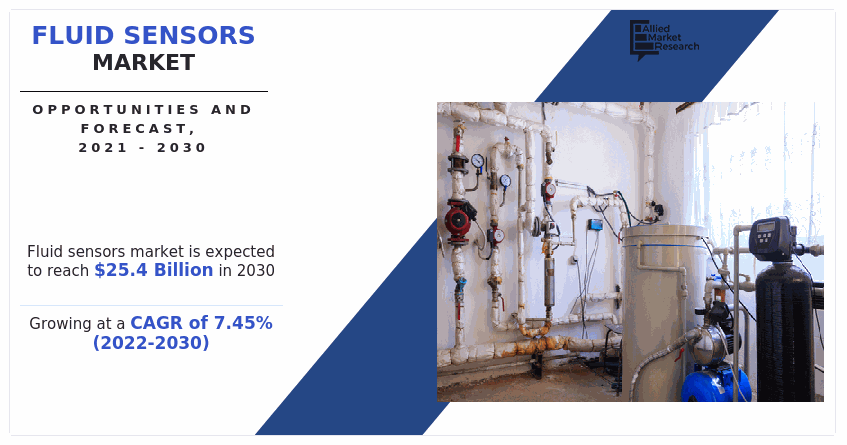
The fluid sensors industry is likely to accelerate its growth in the forecast time period owing to its high demand in the oil & gas industry for various applications such as tank level monitoring and oil quality testing. The demand for crude oil and natural gas has increased as a result of increased mobility and industrialization. Because of the intense and harsh conditions in the oil & gas industry, there is a growing demand for reliable and high-quality sensors. In order to manage the oil composition and environmental conditions, pressure and temperature sensors are increasingly being used in the industry. The expansion of the fluid sensors market growth will also be fueled by the need for multi-level sensors for oil separation in oil drilling operations.
The global fluid sensors industry is segmented on the basis of type, technology, and end user. By type, the market is classified as flow sensor and level sensor. By technology, it is classified as non-contact sensors and contact sensors. By end user, the market is segmented into automotive, water & wastewater, oil & gas, chemical, food & beverages, power & utility and others. By region, the market is analyzed across North America, Europe, Asia-Pacific, and LAMEA.
Segment Overview
The fluid sensors market is segmented into Type, Technology, End-User, and Application.
By type, the flow sensor sub-segment is predicted to have a dominating share in the global market during the forecast period. This is attributed to rising demand for advance feature flow sensors in the petroleum and automobile industries. Flow sensors are increasingly used to control the flow of liquid in the pipes.
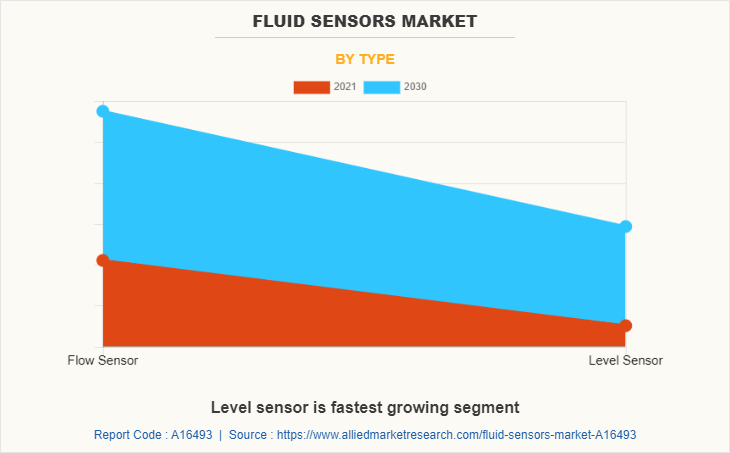
By technology, the non-contact sensor sub-segment is estimated to have a dominating market share in the global market. Non-contact sensors help to eliminate mechanical failures, thereby, ensuring the extension sensors' lifespan. Because of their remote operation capabilities, contactless sensor technologies also provide more precise readings.
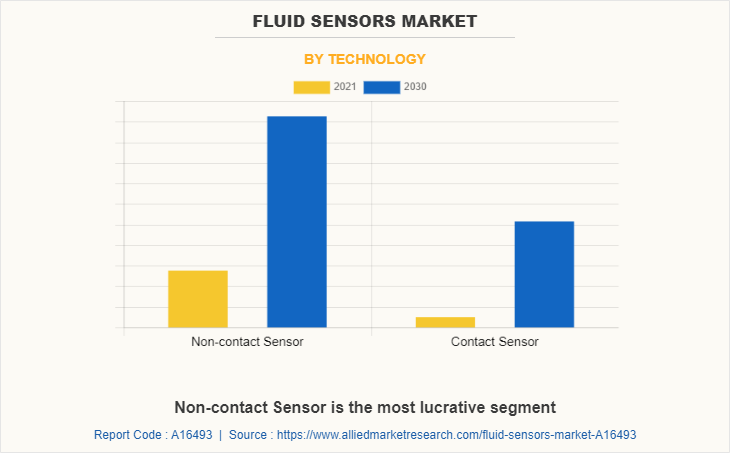
By end user, the power and utility sub-segment is estimated to have a dominating market share in the global market. As the population, globally, the demand for electricity has also increased. This factor has accelerated the growth of fluid sensors market size as fluid sensors are widely used in hydro power plants.
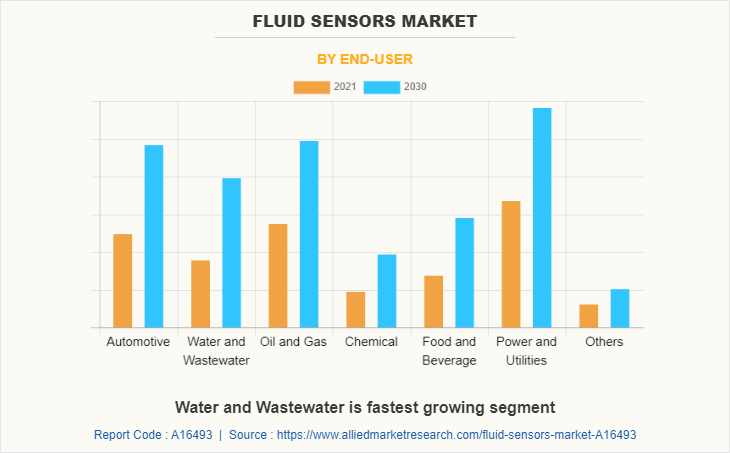
By region, Asia-Pacific is projected to remain the fastest-growing segment during the forecast period. This is attributed to numerous factors such as rapidly growing automobile and petroleum industries in the region.
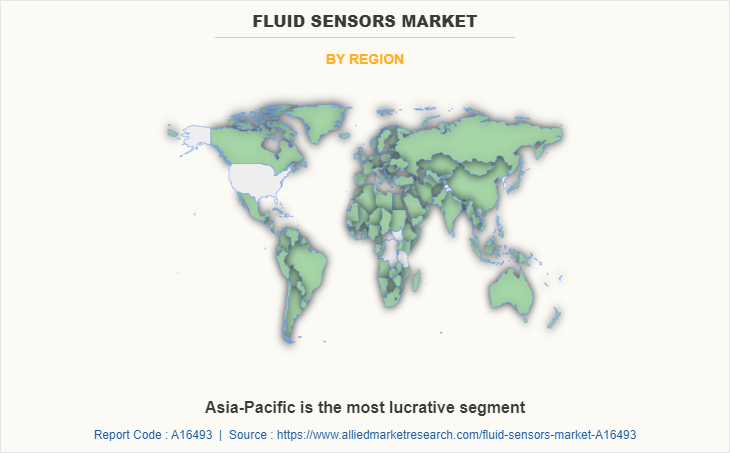
Competitive Analysis
Some of the leading fluid sensors market players are Schneider Electric, Siemens, ABB, Honeywell, Robert Bosch GmbH, Emersion Electric Company, SICK AG, NXP semiconductors, Texas Instruments, and Rockwell Automation.
Key Benefits For Stakeholders
- The report provides an in-depth analysis of the global fluid sensors market trends along with the current and future fluid sensors market forecast.
- This report highlights the key drivers, opportunities, and restraints of the market along with the impact analysis and detailed fluid sensors market outlook during the forecast period.
- Porter’s five forces analysis helps analyze the potential of the buyers & suppliers and the competitive scenario of the global fluid sensors market for strategy building.
- A comprehensive global fluid sensors market analysis covers factors that drive and restrain the market growth as well as fluid sensors market opportunity.
- The qualitative data in this report aims on fluid sensors market opportunity, fluid sensors market forecast scenario, market dynamics, trends, fluid level sensor, fluid level indicator, fluid flow sensor, and developments.
Fluid Sensors Market Report Highlights
| Aspects | Details |
| By Type |
|
| By Technology |
|
| By End-user |
|
| By Region |
|
| Key Market Players | Texas Instruments, ABB, Rockwell Automation, Inc., Schneider Electric, NXP Semiconductors N.V., Sick AG, Robert Bosch GmbH, Emerson Electric Company, Honeywell, Siemens |
Analyst Review
According to the analyst review of the leading companies, the global fluid Sensors market size possesses a substantial scope for growth in the future. Continuous increase in demand for fluid Sensors in industries such as petroleum industry is expected to drive the fluid sensors market share growth. However, high implementation cost of fluid sensors is a major limitation to the market growth. Surge in demand for implementing high quality sensors in wastewater treatment plants and automobile industries are the factors that drive the global fluid sensors market revenue growth. According to the analysts, Asia-Pacific is projected to register faster growth as compared to North American and European markets.
Growing demand from the oil & gas industry where the fluid sensors are used across various applications such as tank level monitoring and oil quality testing are the latest market trends.
Fluid sensors are widely used in automotive, oil & gas, food & beverages, power & utilities, and other end-use industries.
Asia-Pacific is the largest regional market for fluid sensors.
The fluid sensors industry is estimated to reach $25.3 billion by 2030.
The top companies in fluid sensors market are Schneider Electric, Siemens, ABB, Honeywell, Robert Bosch GmbH, Emersion Electric Company, SICK AG, NXP Semiconductors, Texas Instruments, and Rockwell Automation.
Loading Table Of Content...



